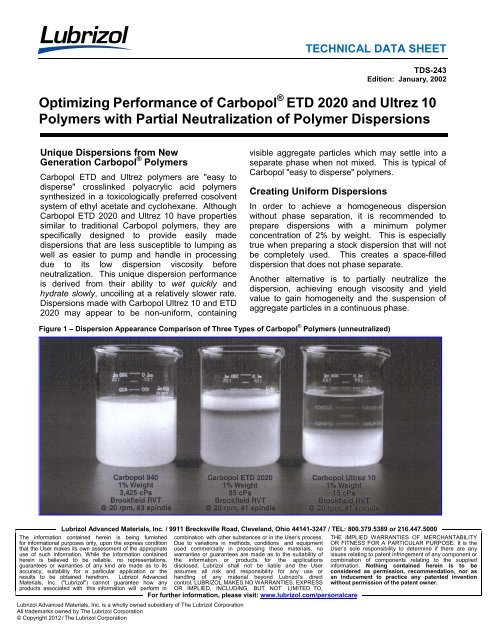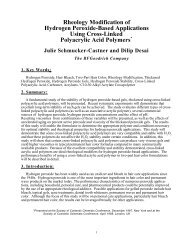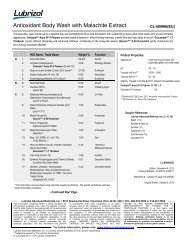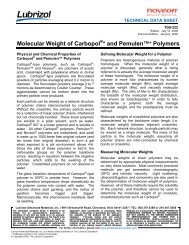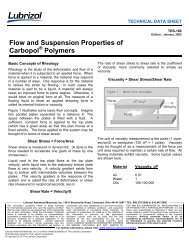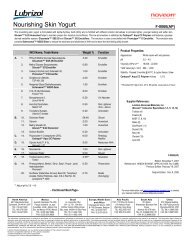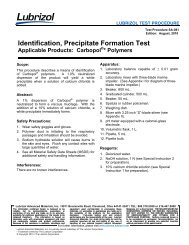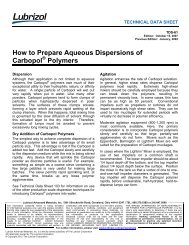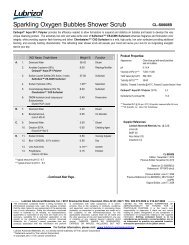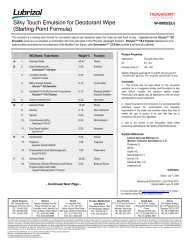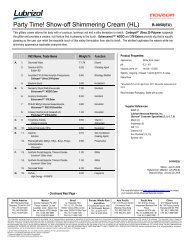TDS-243 - Lubrizol
TDS-243 - Lubrizol
TDS-243 - Lubrizol
You also want an ePaper? Increase the reach of your titles
YUMPU automatically turns print PDFs into web optimized ePapers that Google loves.
TECHNICAL DATA SHEET<br />
<strong>TDS</strong>-<strong>243</strong><br />
Edition: January, 2002<br />
Optimizing Performance of Carbopol ® ETD 2020 and Ultrez 10<br />
Polymers with Partial Neutralization of Polymer Dispersions<br />
Unique Dispersions from New<br />
Generation Carbopol ® Polymers<br />
Carbopol ETD and Ultrez polymers are "easy to<br />
disperse" crosslinked polyacrylic acid polymers<br />
synthesized in a toxicologically preferred cosolvent<br />
system of ethyl acetate and cyclohexane. Although<br />
Carbopol ETD 2020 and Ultrez 10 have properties<br />
similar to traditional Carbopol polymers, they are<br />
specifically designed to provide easily made<br />
dispersions that are less susceptible to lumping as<br />
well as easier to pump and handle in processing<br />
due to its low dispersion viscosity before<br />
neutralization. This unique dispersion performance<br />
is derived from their ability to wet quickly and<br />
hydrate slowly, uncoiling at a relatively slower rate.<br />
Dispersions made with Carbopol Ultrez 10 and ETD<br />
2020 may appear to be non-uniform, containing<br />
visible aggregate particles which may settle into a<br />
separate phase when not mixed. This is typical of<br />
Carbopol "easy to disperse" polymers.<br />
Creating Uniform Dispersions<br />
In order to achieve a homogeneous dispersion<br />
without phase separation, it is recommended to<br />
prepare dispersions with a minimum polymer<br />
concentration of 2% by weight. This is especially<br />
true when preparing a stock dispersion that will not<br />
be completely used. This creates a space-filled<br />
dispersion that does not phase separate.<br />
Another alternative is to partially neutralize the<br />
dispersion, achieving enough viscosity and yield<br />
value to gain homogeneity and the suspension of<br />
aggregate particles in a continuous phase.<br />
Figure 1 – Dispersion Appearance Comparison of Three Types of Carbopol ® Polymers (unneutralized)<br />
<strong>Lubrizol</strong> Advanced Materials, Inc. / 9911 Brecksville Road, Cleveland, Ohio 44141-3247 / TEL: 800.379.5389 or 216.447.5000<br />
The information contained herein is being furnished combination with other substances or in the User’s process. THE IMPLIED WARRANTIES OF MERCHANTABILITY<br />
for informational purposes only, upon the express condition Due to variations in methods, conditions and equipment OR FITNESS FOR A PARTICULAR PURPOSE. It is the<br />
that the User makes its own assessment of the appropriate used commercially in processing these materials, no User’s sole responsibility to determine if there are any<br />
use of such information. While the information contained warranties or guarantees are made as to the suitability of issues relating to patent infringement of any component or<br />
herein is believed to be reliable, no representations, the information or products for the applications combination of components relating to the supplied<br />
guarantees or warranties of any kind are made as to its disclosed. <strong>Lubrizol</strong> shall not be liable and the User information. Nothing contained herein is to be<br />
accuracy, suitability for a particular application or the assumes all risk and responsibility for any use or considered as permission, recommendation, nor as<br />
results to be obtained herefrom. <strong>Lubrizol</strong> Advanced handling of any material beyond <strong>Lubrizol</strong>'s direct an inducement to practice any patented invention<br />
Materials, Inc. ("<strong>Lubrizol</strong>") cannot guarantee how any control. LUBRIZOL MAKES NO WARRANTIES, EXPRESS without permission of the patent owner.<br />
products associated with this information will perform in OR IMPLIED, INCLUDING, BUT NOT LIMITED TO,<br />
For further information, please visit: www.lubrizol.com/personalcare<br />
<strong>Lubrizol</strong> Advanced Materials, Inc. is a wholly owned subsidiary of The <strong>Lubrizol</strong> Corporation<br />
All trademarks owned by The <strong>Lubrizol</strong> Corporation<br />
© Copyright 2012 / The <strong>Lubrizol</strong> Corporation
Dispersions of three different Carbopol polymer<br />
types in Figure 1 illustrate the distinct appearance of<br />
dispersions made with these polymers:<br />
• Carbopol 940 - Homogeneous dispersion<br />
• Carbopol ETD 2020 - Layered phases<br />
• Carbopol Ultrez 10 - Softly settled polymer<br />
particles<br />
The varying appearances are unique to each<br />
Carbopol polymer type. Formulators and processors<br />
working with the various Carbopol polymers need to<br />
keep in mind that it is typical for dispersions with<br />
Carbopol ETD 2020 and Carbopol Ultrez 10 to form<br />
separate layers. These dispersions can be made<br />
uniform with gentle mixing.<br />
Optimizing Performance in<br />
Surfactant Systems<br />
Besides uniform dispersion preparation, this concept<br />
is also helpful when formulating Carbopol ETD<br />
polymers in high-active surfactant systems such as<br />
shampoos, bath gels, hand soaps and facial and<br />
body scrubs. In these systems, high concentrations<br />
of surfactants prevent uncoiling of Carbopol polymer<br />
chains if the polymer neutralization is carried out<br />
after the addition of surfactants. This results in either<br />
low viscosity or yield value of the end product,<br />
graininess, insoluble "jelly particles" (or "fish eyes")<br />
and insoluble precipitates. This is particularly true<br />
when cationics or secondary surfactants, such as<br />
amphoterics or alkyl polyglycosides, are present at<br />
higher levels. Clarity of the final product can also be<br />
adversely affected in such cases.<br />
Normally, for partial neutralization, approximately<br />
10% of total neutralizing agent necessary for the<br />
whole batch should be sufficient. Partial neutralization<br />
will result in an increase in the pH of the<br />
dispersion (approximately 3.8 - 4.0) and viscosity<br />
due to the partial uncoiling or swelling of the<br />
polymer.<br />
The following graph (Figure 2) represents typical<br />
viscosity increases during this procedure.<br />
<strong>TDS</strong>-<strong>243</strong><br />
Optimizing Performance of Carbopol ® ETD 2020 and Ultrez 10<br />
Polymers with Partial Neutralization of Polymer Dispersions<br />
Page 2 of 2<br />
Figure 2<br />
Typical Viscosity Response of Carbopol ® Ultrez 10 and<br />
ETD 2020 During Partial Neutralization Procedure<br />
Neutralized with NaOH (18%)<br />
Any conventional neutralizing agent can be used<br />
in this method but the use of a weaker<br />
neutralizing agent such as a TEA is<br />
recommended for better control of the pH.<br />
Figure 3<br />
Dispersion Viscosities of Various Carbopol ® Polymers


